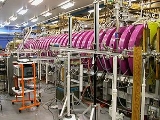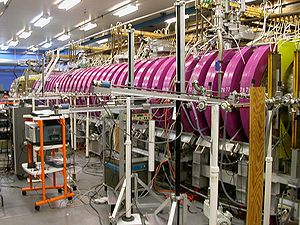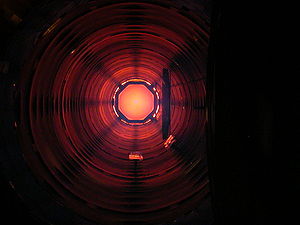
Large Plasma Device
Encyclopedia

Machine overview

Plasma parameters
Because the LaPD is a general-purpose research device, the plasma parameters are carefully selected to make diagnostics simple without the problems associated with hotter (e.g. fusion-level) plasmas, while still providing a useful environment in which to do research.- Density: n = 1-4
 1012 cm−3
1012 cm−3 - Temperature: Te = 6eV, Ti = 1eV
- Background field: B = 400-2500 gauss (40–250 mT)
In principle the plasma may be generated from any gas. Gases typically used are helium
Helium
Helium is the chemical element with atomic number 2 and an atomic weight of 4.002602, which is represented by the symbol He. It is a colorless, odorless, tasteless, non-toxic, inert, monatomic gas that heads the noble gas group in the periodic table...
, argon
Argon
Argon is a chemical element represented by the symbol Ar. Argon has atomic number 18 and is the third element in group 18 of the periodic table . Argon is the third most common gas in the Earth's atmosphere, at 0.93%, making it more common than carbon dioxide...
, nitrogen
Nitrogen
Nitrogen is a chemical element that has the symbol N, atomic number of 7 and atomic mass 14.00674 u. Elemental nitrogen is a colorless, odorless, tasteless, and mostly inert diatomic gas at standard conditions, constituting 78.08% by volume of Earth's atmosphere...
, neon
Neon
Neon is the chemical element that has the symbol Ne and an atomic number of 10. Although a very common element in the universe, it is rare on Earth. A colorless, inert noble gas under standard conditions, neon gives a distinct reddish-orange glow when used in either low-voltage neon glow lamps or...
and (for short periods of time, as it destroys the oxide coating on the cathode) hydrogen
Hydrogen
Hydrogen is the chemical element with atomic number 1. It is represented by the symbol H. With an average atomic weight of , hydrogen is the lightest and most abundant chemical element, constituting roughly 75% of the Universe's chemical elemental mass. Stars in the main sequence are mainly...
.
At these parameters, the ion Larmor radius is a few millimeters, and the Debye length
Debye length
In plasma physics, the Debye length , named after the Dutch physicist and physical chemist Peter Debye, is the scale over which mobile charge carriers screen out electric fields in plasmas and other conductors. In other words, the Debye length is the distance over which significant charge...
is tens of micrometres. Importantly, it also implies that the Alfvén wavelength is a few meters, and in fact shear Alfvén waves are routinely observed in LaPD. This is the main reason for the 20-meter length of the device.
Plasma source
Plasma is produced via discharge from a barium-oxide coated cathode, which emits electrons via thermionic emissionThermionic emission
Thermionic emission is the heat-induced flow of charge carriers from a surface or over a potential-energy barrier. This occurs because the thermal energy given to the carrier overcomes the binding potential, also known as work function of the metal. The charge carriers can be electrons or ions, and...
. The cathode itself is made from a thin nickel sheet, uniformly heated to roughly 900 °C. The circuit is closed by a molybdenum mesh anode a short distance away. Typical discharge currents are in the range of 3-8 kiloamperes at 60-90 volts, supplied by a custom-designed transistor switch backed by a 4-farad
Farad
The farad is the SI unit of capacitance. The unit is named after the English physicist Michael Faraday.- Definition :A farad is the charge in coulombs which a capacitor will accept for the potential across it to change 1 volt. A coulomb is 1 ampere second...
capacitor bank.
The plasma is pulsed at 1 Hz, and is typically on for 10-20 milliseconds at a time. The use of an oxide-cathode plasma source, along with a well-designed transistor switch for the discharge, allows for a plasma environment which is extremely reproducible shot-to-shot.
One interesting aspect of the LaPD plasma source is its ability to act as an "Alfvén Maser
Maser
A maser is a device that produces coherent electromagnetic waves through amplification by stimulated emission. Historically, “maser” derives from the original, upper-case acronym MASER, which stands for "Microwave Amplification by Stimulated Emission of Radiation"...
", a source of large-amplitude, coherent shear Alfvén waves. The resonant cavity is formed by the highly reflective nickel cathode and the semitransparent grid anode. Since the source is located at the end of the solenoid
Solenoid
A solenoid is a coil wound into a tightly packed helix. In physics, the term solenoid refers to a long, thin loop of wire, often wrapped around a metallic core, which produces a magnetic field when an electric current is passed through it. Solenoids are important because they can create...
which generates the main LaPD background field, there is a gradient in the magnetic field within the cavity. As shear waves do not propagate above the ion cyclotron frequency, the practical effect of this is to act as a filter on the modes which may be excited. Maser activity occurs spontaneously at certain combinations of magnetic field strength and discharge current, and in practice may be activated (or avoided) by the machine operator.
Diagnostic access and probes
The main LaPD diagnostic is the movable probe. The relatively low electron temperature makes probe construction straightforward and does not require the use of exotic materials. Probes currently used at the facility include magnetic field probes, Langmuir probeLangmuir probe
A Langmuir probe is a device named after Nobel Prize winning physicist Irving Langmuir, used to determine the electron temperature, electron density, and electric potential of a plasma. It works by inserting one or more electrodes into a plasma, with a constant or time-varying electric potential...
s, Mach probes (to measure flow) and many others. Standard probe design also allows external users to bring their own diagnostics with them, if they desire. Each probe is inserted through its own vacuum interlock, which allows probes to be added and removed while the device is in operation.
A 1 Hz rep-rate, coupled with the high reproducibility of the background plasma, allows the rapid collection of enormous datasets. An experiment on LaPD is typically designed to be repeated once per second, for as many hours or days as is necessary to assemble a complete set of observations. This makes it possible to diagnose experiments using a small number of movable probes, in contrast to the large probe arrays used in many other devices.
The entire length of the device is fitted with "ball joints," vacuum-tight angular couplings (invented by a LaPD staff member) which allow probes to be inserted and rotated, both vertically and horizontally. In practice, these are used in conjunction with computer-controlled motorized probe drives to sample "planes" (vertical cross-sections) of the background plasma with whatever probe is desired. Since the only limitation on the amount of data to be taken (number of points in the plane) is the amount of time spent recording shots at 1 Hz, it is possible to assemble large volumetric datasets consisting of many planes at different axial locations.
Visualizations composed from such volumetric measurements can be seen at the LaPD gallery.
Including the ball joints, there are a total of 450 access ports on the machine, many of which are fitted with windows for optical or microwave observation. Other diagnostics at LaPD include a microwave interferometer, fast (3 ns) photography and laser-induced fluorescence
Laser-induced fluorescence
Laser-induced fluorescence is a spectroscopic method used for studying structure of molecules, detection of selective species and flow visualization and measurements....
.

